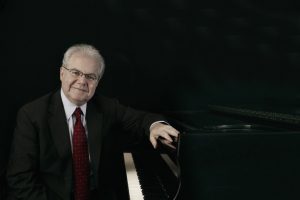
By Márcio Bezerra
Acclaimed pianist Emanuel Ax was the feature of a sold-out recital Jan. 8 at The Society of the Four Arts in Palm Beach.
Playing a mostly Schubert program with some touches of Liszt, the venerable artist displayed a total commitment to serving the composers’ intentions, with little space for personal eccentricities.
Following Arthur Rubinstein’s example, Ax is a musician who honors the text above everything else — in his readings, one should not look for revelatory insights other than the ones offered by the composers themselves.
That approach served the music of Franz Schubert well, as made clear in the Sunday afternoon recital.
The pianist opened the program with Schubert’s Sonata in A major (D. 644), a late masterwork full of memorable melodies so characteristic of an unmatched songwriter.
Ax’s voicing was superb, and his approach to rubato was discreet and to the point. His straightforwardness brought clarity to Schubert’s unique handling of sonata form, which has been misunderstood by so many generations of critics and musicologists since his early death. Indeed, if one cannot compare Schubert’s sonatas to the towering achievements of Beethoven, their discreet weirdness suits well our postmodern taste (more on that later).
Of the many composers of the next generation, Franz Liszt was a sincere admirer and promoter, especially of Schubert’s vocal output. He even conducted the premiere of Schubert’s little-known (and to this day unsuccessful) opera Alfonso und Estrella (D. 732), and transcribed many of the lieder for piano solo, adding his own romantic sensibility to the short masterworks.
Ax performed four such transcriptions, once more approaching them with delicate sound and clarity of melodic lines.
This suave approach was less successful in the next selection, Liszt’s Vallée d’Obermann. The most ambitious piece of the first album of Années de Pèlerinage, it reflects the composer’s awe of the Alpine landscape and his fascination with Romantic literary heroes.
That heroism was absent in Ax’s reading — his fortes were not forceful enough and his bravura displays were mostly flat. As the music of Liszt is less sophisticated than Schubert’s, a more personalized approach is needed to “save” the composer’s from sounding banal.
Fortunately, the pianist returned to Schubert for the second half of the program, which consisted of a single work, the Piano Sonata in B-flat major (D. 960).
The last piano sonata written by Schubert, it was published posthumously (just like D. 644). One does not need to look to a distant past to read unfavorable criticisms of the composer’s sonatas, and it was not until his death’s centennial that they started to be taken seriously by musicologists and critics.
At issue were the use of extended melodies that cripple motivic development a la Beethoven, the lack of dramatic contrast among movements, and an unorthodox handling of tonal relations.
To our postmodern ears, finally getting some respite from the total serialism disaster of the 1950s, their charm has a clear appeal, especially when performed with the authority of Emanuel Ax.
Once again, the pianist worked as an ideal intermediate between composer and audience, adding almost no idiosyncratic touches and allowing the music to speak for itself. He handled the first movement superbly well, choosing to skip the repeat of the exposition in order to keep the work more balanced. His voicing was exquisite; the sound heavenly.
His treatment of the inner movements was sensible and in the finale he added a little extra time to the ominous bare octaves that come from time to time, stressing the unease and suspense hidden in this otherwise “nice” music.
The Society of the Four Arts is to be commended for bringing artists of the stature of Ax. The Gubelmann Auditorium has the acoustics, instrument, and size to host a perfect piano recital and one surely hopes that many more will come in the upcoming seasons.